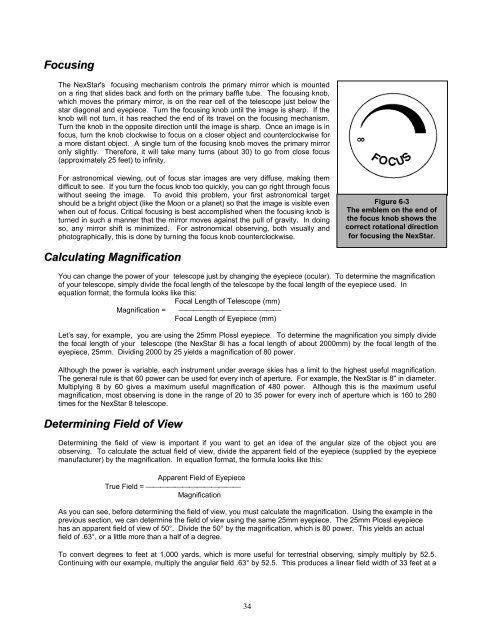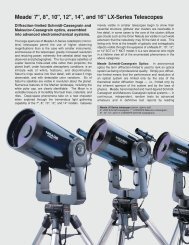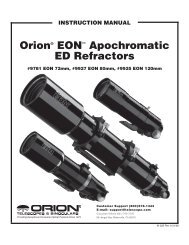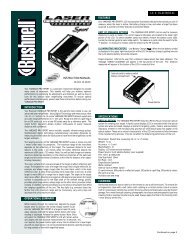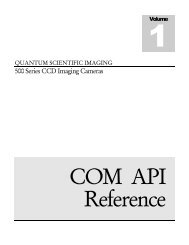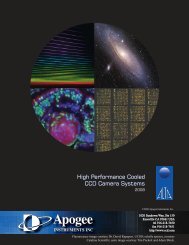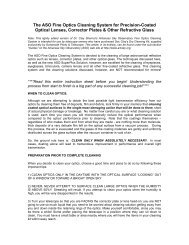INSTRUCTION MANUAL
INSTRUCTION MANUAL
INSTRUCTION MANUAL
Create successful ePaper yourself
Turn your PDF publications into a flip-book with our unique Google optimized e-Paper software.
Focusing<br />
The NexStar's focusing mechanism controls the primary mirror which is mounted<br />
on a ring that slides back and forth on the primary baffle tube. The focusing knob,<br />
which moves the primary mirror, is on the rear cell of the telescope just below the<br />
star diagonal and eyepiece. Turn the focusing knob until the image is sharp. If the<br />
knob will not turn, it has reached the end of its travel on the focusing mechanism.<br />
Turn the knob in the opposite direction until the image is sharp. Once an image is in<br />
focus, turn the knob clockwise to focus on a closer object and counterclockwise for<br />
a more distant object. A single turn of the focusing knob moves the primary mirror<br />
only slightly. Therefore, it will take many turns (about 30) to go from close focus<br />
(approximately 25 feet) to infinity.<br />
For astronomical viewing, out of focus star images are very diffuse, making them<br />
difficult to see. If you turn the focus knob too quickly, you can go right through focus<br />
without seeing the image. To avoid this problem, your first astronomical target<br />
should be a bright object (like the Moon or a planet) so that the image is visible even<br />
when out of focus. Critical focusing is best accomplished when the focusing knob is<br />
turned in such a manner that the mirror moves against the pull of gravity. In doing<br />
so, any mirror shift is minimized. For astronomical observing, both visually and<br />
photographically, this is done by turning the focus knob counterclockwise.<br />
Figure 6-3<br />
The emblem on the end of<br />
the focus knob shows the<br />
correct rotational direction<br />
for focusing the NexStar.<br />
Calculating Magnification<br />
You can change the power of your telescope just by changing the eyepiece (ocular). To determine the magnification<br />
of your telescope, simply divide the focal length of the telescope by the focal length of the eyepiece used. In<br />
equation format, the formula looks like this:<br />
Focal Length of Telescope (mm)<br />
Magnification = ⎯⎯⎯⎯⎯⎯⎯⎯⎯⎯⎯⎯⎯⎯<br />
Focal Length of Eyepiece (mm)<br />
Let’s say, for example, you are using the 25mm Plossl eyepiece. To determine the magnification you simply divide<br />
the focal length of your telescope (the NexStar 8i has a focal length of about 2000mm) by the focal length of the<br />
eyepiece, 25mm. Dividing 2000 by 25 yields a magnification of 80 power.<br />
Although the power is variable, each instrument under average skies has a limit to the highest useful magnification.<br />
The general rule is that 60 power can be used for every inch of aperture. For example, the NexStar is 8" in diameter.<br />
Multiplying 8 by 60 gives a maximum useful magnification of 480 power. Although this is the maximum useful<br />
magnification, most observing is done in the range of 20 to 35 power for every inch of aperture which is 160 to 280<br />
times for the NexStar 8 telescope.<br />
Determining Field of View<br />
Determining the field of view is important if you want to get an idea of the angular size of the object you are<br />
observing. To calculate the actual field of view, divide the apparent field of the eyepiece (supplied by the eyepiece<br />
manufacturer) by the magnification. In equation format, the formula looks like this:<br />
Apparent Field of Eyepiece<br />
True Field = ⎯⎯⎯⎯⎯⎯⎯⎯⎯⎯⎯⎯⎯<br />
Magnification<br />
As you can see, before determining the field of view, you must calculate the magnification. Using the example in the<br />
previous section, we can determine the field of view using the same 25mm eyepiece. The 25mm Plossl eyepiece<br />
has an apparent field of view of 50°. Divide the 50° by the magnification, which is 80 power. This yields an actual<br />
field of .63°, or a little more than a half of a degree.<br />
To convert degrees to feet at 1,000 yards, which is more useful for terrestrial observing, simply multiply by 52.5.<br />
Continuing with our example, multiply the angular field .63° by 52.5. This produces a linear field width of 33 feet at a<br />
34


